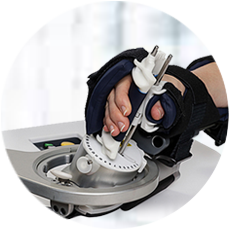InMotion® Robotics for Physical Therapy
Want to talk to a clinical specialist?
Compelling Gait Research Presented by:
Dr. Kari Fisher OTD, OTR/L, C/NDT
Case Example: 66 y/o patient “massive” Ischemic CVA.
Therapy utilizes InMotion Robotics to promote improved Gait performance.
Alternate Patient Positions
Alternate patient positions open up new treatment options for Physical Therapists. Now increase trunk control, stability and balance by engaging the patient with InMotion Arm while in alternate positions.
Alternate Positions:
- Dynamic Sitting
- Kneeling
- Standing
InMotion® Therapy: Extensive Evidence Base: 25+ years of Research and more than 150 Independent Peer-reviewed Publications
InMotion® Robots have been tested by leading medical centers in more than 150, independent controlled clinical trials, including large randomized, double-blind, peer-reviewed clinical studies involving more than 1700 patients.
-
Adult and Pediatric patients (4 years and older)
-
Acute, subacute and chronic phases of recovery
-
Severe, moderate and mild levels of impairment
BIONIK’s modular approach to neurorehabilitation is optimizes the use of robotics and is consistent with the latest neuro-scientific research. InMotion® Interactive Therapy serves as an effective adjunct to existing physical and occupational therapy approaches.
Advanced Technology: Powered by Robotic A.I.
BIONIK robotic products have exceptional capacity for patient assessment and real-time interactive response, which sets them apart from other therapy systems.
- Senses the patient’s movement and responds to a patient’s continually-changing ability
- Robots guide the exercise treatment accordingly
- If the patient is unable to move, the robot gently assists the patient to initiate movement towards the target
- If coordination is a problem, the robot “guides” the movement, allowing the patient to move towards the target and making certain that the patient is practicing the movement
the correct way - As the patient gains movement control, the robot provides less assistance and continually challenges the patient
- Provides quantifiable feedback on progress and performance








